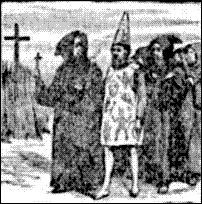CLICK: TCW's Latest on Damning Doctrine of Antipope "Bob from Chicago"
True Catholic News
In Today's Catholic World News Blog
Image of 17th c. sanbenitos (Tui, Spain Cathedral "museum").
"a convicted heretic could be sentenced to wear this garment
of shame [sanbenito] for periods ranging from one year to life."
One of the most common sanctions that all convicted heretics commonly received remained the enforced use of a garment of shame, called a sanbenito. Sanbenitos consisted of a type of rough linen cloth tunic or smock that could be white, yellow, or black depending on the region and particular traditions of the regional tribunal. Depending on the gravity of the crime of the convicted heretic, the garment had different adornments on it to symbolize the heretic’s crime and penance. The most common type of adornment consisted of a red or black Saint Andrew’s cross emblazoned on the front and back of the garment. A reconciled heretic’s garment could also hold images of flames and demons or devils to inspire terror or fear. Those convicted of strong suspicions of heresy wore a sanbenito with a full Saint Andrew’s cross, sometimes accompanied by a high conical hat of shame made out of stiff fabric or pressed paper called a coroza.
A convicted heretic [enemy of God and murderer of eternal souls]
publicly being humiliated wearing sanbenito garment & coroza "hat".
The sanbenito was usually worn over the clothes of a convicted heretic. The garment that resembled a type of apron or tunic when worn usually came down to the person’s knees and opened on the side. As a punitive sentence, a convicted heretic could be sentenced to wear this garment of shame for periods ranging from one year to life. Once the period of the sentence ended, the Holy Inquisition ordered the convicted heretic’s sanbenito with the convict’s name and the particulars of his crime hung on the walls or ceilings of his local parish church. The permanent display of this garment of shame with the heretic’s family name and his accused crime against the faith served as a perpetual reminder of his act of heresy for the entire parish.
"All the san benitos of the condemned, living or dead, present or absent, be placed in the churches where they used to live…in order that there may be perpetual memory of the infamy of the heretics and their descendants." (Inquisition Tribunal 1561)
Periodically the inquisitors or their designated assistants, also conducted visitations of the parish churches in their district with the goal of ensuring that all of these publicly displayed sanbenitos remained in place. Whenever the garments disappeared or appeared damaged, or deteriorated, the Holy Inquisition ordered them replaced. (End)
"Above all have a horror of heresy... "
(Extract from Fr. Salvany's book "Liberalism Is A Sin", Chp. XV, p. 97)
"Almighty God... Thou who dost bestow, preserve, and reward the virtues...
confirm me in the firm foundation of faith" (Prayer of St. Thomas Aquinas)
Related Links:
The Holy Inquisition Today (As Approbated by the True Papacy in Exile)
King Philip II Established Holy Inquisition in New World
Examples of Punishable Crimes by Inquisition in "USA"
"Catechism On Modernism According To The Encyclical 'Pascendi Dominici Gregis' Of His Holiness Pius X" (From the French of Fr. Jean Baptiste Lemius, Oblate of Mary Immaculate, Authorized Translation by Fr. John Fitzpatrick, 1908)
"Rather ought every one submit to death, than to receive
the sacrament of communion from a hand of a heretic."
(Pope St. Gregory the Great, Church Father and Doctor)
Blessed be St. Peter, Prince of the Apostles!
The Papal Restoration Staff
Ecclesiastical Approbation
In Today's Catholic World (TCWBLOG.com) carries the approbation in writing of the Holy See in exile. It faithfully adheres to the rules for Catholic Journals mandated by Leo XIII in the Apostolic Constitution Officiorum ac Munerum, January 25, 1897 - so heavily re-stressed by Pius X in Pascendi Dominici Gregis, September 8, 1907.
Dec. 7, 2014






